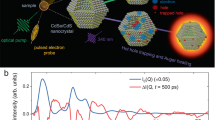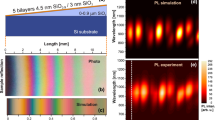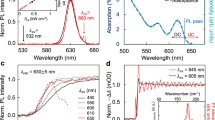Abstract
Carrier multiplication by generation of two or more electron–hole pairs following the absorption of a single photon may lead to improved photovoltaic efficiencies1 and has been observed in nanocrystals made from a variety of semiconductors, including silicon. However, with few exceptions2, these reports have been based on indirect ultrafast techniques3,4,5,6. Here, we present evidence of carrier multiplication in closely spaced silicon nanocrystals contained in a silicon dioxide matrix by measuring enhanced photoluminescence quantum yield. As the photon energy increases, the quantum yield is expected to remain constant, or to decrease as a result of new trapping and recombination channels being activated. Instead, we observe a step-like increase in quantum yield for larger photon energies that is characteristic of carrier multiplication7. Modelling suggests that carrier multiplication is occurring with high efficiency and close to the energy conservation limit.
This is a preview of subscription content, access via your institution
Access options
Subscribe to this journal
Receive 12 print issues and online access
$259.00 per year
only $21.58 per issue
Buy this article
- Purchase on Springer Link
- Instant access to full article PDF
Prices may be subject to local taxes which are calculated during checkout




Similar content being viewed by others
Change history
21 October 2011
In the version of this Letter originally published online, the third sentence of the abstract should have read: "Here, we present evidence of carrier multiplication in closely spaced silicon nanocrystals contained in a silicon dioxide matrix by measuring enhanced photoluminescence quantum yield." This has been corrected in all versions of the Letter.
References
Green, M. A. Third Generation Photovoltaics (Springer-Verlag, 2003).
Sambur, J. B., Novet, T. & Parkinson, B. A. Multiple exciton collection in a sensitized photovoltaic system. Science 330, 63–66 (2010).
Shabaev, A., Efros, A. L. & Nozik, A. J. Multiexciton generation by a single photon in nanocrystals. Nano Lett. 6, 2856–2863 (2006).
Schaller, R. D., Sykora, M., Pietryga, J. M. & Klimov, V. I. Seven excitons at the cost of one: redefining the limits for conversion efficiency of photons into charge carriers. Nano Lett. 6, 424–429 (2006).
Beard, M. C. et al. Multiple exciton generation in colloidal silicon nanocrystals. Nano Lett. 7, 2506–2512 (2007).
Thrinh, M. T. et al. In spite of recent doubts carrier multiplication does occur in PbSe nanocrystals. Nano Lett. 8, 1713–1718 (2008).
Beard, M. C. et al. Comparing multiple exciton generation in quantum dots to impact ionization in bulk semiconductors: implications for enhancement of solar energy conversion. Nano Lett. 10, 3019–3027 (2010).
Vavilov, S. I. Die Fluoreszenzausbeute von Farbstof losungen als Funktion der Wellenlange des anregenden Lichtes. Z. Physik. 42, 311–318 (1927).
Cruz, R. A., Pilla, V. & Catunda, T. Quantum yield excitation spectrum (UV-visible) of CdSe/ZnS core–shell quantum dots by thermal lens spectrometry. J. Appl. Phys. 107, 083504 (2010).
Alivisatos, A. P. Semiconductor clusters, nanocrystals, and quantum dots. Science 271, 933–937 (1996).
Allan, G. & Delerue, C. Fast relaxation of hot carriers by impact ionization in semiconductor nanocrystals: role of defects. Phys. Rev. B 79, 195324 (2009).
Cooney, R. R. et al. Breaking the phonon bottleneck for holes in semiconductor quantum dots. Phys. Rev. Lett. 98, 177403 (2007).
Pandey, A. & Guyot-Sionnest, P. Slow electron cooling in colloidal quantum dots. Science 322, 929–932 (2008).
Kanzawa, Y. et al. Size-dependent near-infrared photoluminescence spectra of Si nanocrystals embedded in SiO2 matrix. Solid State Commun. 7, 533–537 (1997).
Valenta, J. & Linnros, J. in Silicon Nanophotonics: Basic Principles, Present Status and Perspectives (ed. Khriachtchev, L.) Ch. 7 (World Scientific Publishing, 2009).
Godefroo, S. et al. Classification and control of the origin of photoluminescence from Si nanocrystals. Nature Nanotech. 3, 174–178 (2008).
Wolkin, M. V., Jorne, J., Fauchet, P. M., Allan, G. & Delerue, C. Electronic states and luminescence in porous silicon quantum dots: the role of oxygen. Phys. Rev. Lett. 82, 197–200 (1999).
de Boer, W. D. A. M., et al. Red spectral shift and enhanced quantum efficiency in phonon-free photoluminescence from silicon nanocrystals. Nature Nanotech. 5, 878–884 (2010).
de Mello, J. C., Wittmann, H. F. & Friend, R. H. An improved experimental determination of external photoluminescence quantum efficiency. Adv. Mater. 9, 230–232 (1997).
Miura, S., Nakamura, T., Fujii, M., Inui, M. & Hayashi, S. Size dependence of photoluminescence quantum efficiency of Si nanocrystals. Phys. Rev. B 73, 245333 (2006).
Timmerman, D., Izeddin, I. & Gregorkiewicz, T. Saturation of luminescence from Si nanocrystals embedded in SiO2 . Phys. Status Solidi A 207, 783–187 (2010).
Wegh, R. T., Donker, H., Oskam, K. D. & Meijerink, A. Visible quantum cutting in LiGdF4:Eu3+ through downconversion. Science 283, 663–666 (1999).
Miritello, M., Lo Salvio, R., Cardile, P. & Priolo, F. Enhanced down conversion of photons emitted by photoexcited ErxY2–xSi2O7 films grown on silicon. Phys. Rev. B 81, 041411(R) (2010).
Dexter, D. L. Possibility of luminescent quantum yields greater than unity. Phys. Rev. 108, 630–633 (1957).
Gabor, N. M., Zhong, Z., Bosnick, K., Park, J. & McEuen, P. L. Extremely efficient multiple electron–hole pair generation in carbon nanotube photodiodes. Science 325, 1367–1371 (2009).
Nozik, A. J. Quantum dot solar cells. Physica E 14, 115–120 (2002).
Werner, J. H., Kolodinski, S. & Queisser, H. J. Novel optimization principles and efficiency limits for semiconductor solar cells. Phys. Rev. Lett. 72, 3851–3854 (1994).
Timmerman, D., Izzedin, I., Stallinga, P., Yassievich, I. N. & Gregorkiewicz, T. Space-separated quantum cutting with Si nanocrystals for photovoltaic applications. Nature Photon. 2, 105–109 (2008).
Valenta, J. et al. Light-emisssion performance of silicon nanocrystals deduced from single nanocrystal spectroscopy. Adv. Funct. Mater. 18, 2666–2672 (2008).
de Boer, W. D. A. M. et al. Increased carrier generation rate in Si nanocrystals in SiO2 investigated by induced absorption. Appl. Phys. Lett. 99, 053126 (2011).
Švrček, V., Slaoui, A. & Muller, J. C. Silicon nanocrystals as light converter for solar cells. Thin Solid Films 451–452, 384–388 (2004).
Wolf, M., Brendel, R., Werner, J. H. & Queisser, H. J. Solar cell efficiency and carrier multiplication in Si1–xGex alloys. J. Appl. Phys. 83, 4213–4221 (1998).
Acknowledgements
This work was financially supported by Nederlandse Organisatie voor Wetenschappleijk Onderzoek (NWO), Stichting voor de Technologische Wetenschappen (STW) and Stichting der Fundamenteel Onderzoek der Materie (FOM). Part of this work (J.V.) was supported by Research Centre LC510 and Research Plan MSM0021620835 of the Ministry of Education, Youth and Sports and Project KAN400100701 of the Grant Agency of the Academy of Sciences of the Czech Republic.
Author information
Authors and Affiliations
Contributions
D.T. and T.G. conceived the project, co-wrote the paper and, together with J.V. and K.D., designed the experiments. D.T., J.V. and K.D. performed the experiments and contributed to data analysis. D.T. and K.D. prepared sputtered and po-Si materials, respectively. T.G. supervised the project. All authors discussed the results and commented on the manuscript.
Corresponding author
Ethics declarations
Competing interests
The authors declare no competing financial interests.
Supplementary information
Rights and permissions
About this article
Cite this article
Timmerman, D., Valenta, J., Dohnalová, K. et al. Step-like enhancement of luminescence quantum yield of silicon nanocrystals. Nature Nanotech 6, 710–713 (2011). https://doi.org/10.1038/nnano.2011.167
Received:
Accepted:
Published:
Issue Date:
DOI: https://doi.org/10.1038/nnano.2011.167
This article is cited by
-
Exploring the Design and Spectroscopic Characteristics of PVA/Si3N4/SiBr4 New Structures for Electronics and Optics Devices
Silicon (2023)
-
Efficient carrier multiplication in CsPbI3 perovskite nanocrystals
Nature Communications (2018)
-
Photon antibunching in a cluster of giant CdSe/CdS nanocrystals
Nature Communications (2018)
-
Charge carrier localised in zero-dimensional (CH3NH3)3Bi2I9 clusters
Nature Communications (2017)
-
Non-Poissonian photon statistics from macroscopic photon cutting materials
Nature Communications (2017)



